Youth Job Creation Policy Primer
“What we need is a pipeline that flows from entry into education all the way to a fulfilling job.”






“What we need is a pipeline that flows from entry into education all the way to a fulfilling job.”






The subject of this report could not be more important – to young people themselves, but also to the prosperity and stability of the countries where we work, and to the UK. There is a global jobs problem that is increasingly youthful. Over the next decade a billion more young people will enter the job market, mainly in Asia and Sub-Saharan Africa. An estimated 18 million new jobs will be needed each year until 2035 to absorb the growing labour force in Sub-Saharan Africa. And the African Development Bank estimates that, without concerted action, nearly 50% of youth will be unemployed or economically inactive by 2025.
Young people have the potential to shape the future of their countries, growing markets for international investment and building a future that is both in their interest, and in ours. However, if young people feel marginalized, they can fuel instability and increase tensions or fall victim to violent extremism and conflict. Unless more and better jobs are created, services such as health and education will suffer and migration pressures will grow.
The UK has invested a great deal in helping increased numbers of children in developing countries to survive the health and nutrition challenges of childhood. We must ensure that as they grow, they can develop the resilience and skills they need to overcome poverty and adversity, and to build a positive future within their own national borders.
Education, particularly beyond the primary level, is key to improving young people’s lives and economic opportunities – especially for girls. An extra year of primary schooling for girls can increase their wages by 10-20%, most of
which is likely to be reinvested in their families and communities. I am therefore proud that my Department prioritises getting more girls to access and stay in education, and make the critical transition from primary to secondary school. I am also proud that as these children then move into adulthood, we prepare them for the workplace by providing skills such as critical thinking, problem solving, team working, digital literacy, resilience and tolerance of diversity.
I believe the UK must significantly increase its support for, and investment in creating good jobs for young people. We must also consider how we can best prepare young people to access new economic opportunities. This can only be done through dynamic partnerships between the private sector, civil society and governments.
DFID’s first ever Economic Development Strategy lays the ground for how we will work across the UK Government to establish new trade, investment and economic links to end poverty. The emphasis is on creating more and better jobs, enabling businesses to grow, supporting better infrastructure, technology, connectivity and a skilled and healthy workforce. It also stresses that those who are routinely excluded, including girls and women, people with disabilities, and the world’s poorest people, must benefit from inclusive growth. The challenges ahead are huge, but we all stand to benefit - and our young people deserve nothing less.
Chair, Parliamentary Network for the World Bank and IMF
Lead Author: David Woollcombe
Editorial Consultant: Nick Aveling
Designer: Simon Judd, SJ Creative
Editorial Advisors:
• Aldridge Foundation – Beki Martin

I am convinced that, with visionary leadership, we can solve the youth unemployment crisis and, by doing so, we will solve so much else: peace, security and an end to poverty in Less Economically Developed Countries (LEDCs). In this booklet, we promote the ‘combination’ or Systems Approach: starting from an early age, youth must be given the skills and career guidance to prosper in the world of work, especially in LEDCs where the vast majority will be forced to make their livelihoods from self-employment and enterprise. As policymakers, we must embrace that reality – and others, like the difficulty of accessing capital, registering a business or getting access to the internet so essential to all 21st Century job creation.
We don’t know everything: we know we need better metrics to compare the effectiveness – particularly the cost-effectiveness – of different interventions. But because the benefits that flow from successful youth job creation are so enormous, (a US$3 to US$5 trillion dividend for the global economy according to the World Bank) – I urge you all to get started. For young people in jobs grow economies; young people without jobs deplete them. Clearly, we need more of the former and less of the latter.
• Business and Sustainable Development Commission – Helen Hai, Clare Oh
• Cambridge Development InitiativePatrick Hoffman, Jack Atherton
• Commonwealth Youth Division - Katherine Ellis, Layne Robinson, Sushil Ram
• DFID - Moira KcKerracher, Kate Wilkinson
• ILO - Markus Pilgrim
• Hand in Hand Intl. - Nick Aveling, Agnes Svensson
• Intl. Youth Foundation - Bill Reese
• Peace Child Intl. - Rob Giddings
• Plan Intl. - Richard Street, Simon Bishop
• Raleigh International – Stacey Adams, Julian Olivier, Hannah Richards
• Rockstar Mentors - Jonathan Pfahl
• Teach a Man to Fish - Amelie Heuer
• World Bank - David Robalino, Victoria Strokova
• Youth Business Intl. - Andrew Fiddaman
Links to source documents for facts used in this Primer can be found at: www.youthjobcreation.org

Automation: Mark Carney, Governor of the Bank of England, says “automation will put half the jobs in the UK at risk”. That includes more than 98% of jobs in insurance and thousands of administrative and office jobs. Transportation jobs will also disappear as driverless cars and trucks fill our roads.
Lack of access to capital: 91% of youth told us scant access to startup funding is the biggest obstacle to starting an enterprise. Many youth are also terrified of taking on debt.
Skills mismatching: In many countries, schools and colleges still focus heavily on Humanities not STEM subjects (science, technology, engineering and mathematics), resulting in too few engineers and IT professionals being trained.
About 75 million youth are registered unemployed worldwide but many millions more are under-employed. 620 million are idle or not looking for work, and 600 million more will join the workforce by 2030 with fewer than 300 million jobs awaiting them. So - the world needs to create about a billion jobs by 2030 (18 million a year in Africa alone) to meet SDG 8. There is no greater challenge in international development.
Lack of focus on women’s employment: Women’s value as entrepreneurs and income-generators is often constrained by cultural attitudes, family traditions and, sometimes, government legislation.
Lack of focus on Household Enterprises
(HEs): Statistics show that 80-95% of bottom-of-the-pyramid youth will earn mixed livelihoods in household enterprises and self-employment. But most schools still educate students as though they will all get jobs in the formal waged sector.
Inadequate metrics: World Bank & ILO researchers decry the “infrequent presentation of standardized programme cost measures alongside impact evaluation results.” Senior economists at both institutions, have so far not expressed any confidence in existing job creation impact measures.
Faced with the scale and complexity of the challenge, policymakers might be forgiven for burying youth job creation at the very bottom of their to-do lists. That would be a calamitous mistake. For years, the practitioners behind this Policy Primer have been chipping away at the problems. We are confident that, implemented systemically at scale, the suite of solutions presented here can achieve SDG 8.
The main thing we have learned is that piecemeal approaches to youth job creation don’t work. The World Bank and ILO conclude: “Programmes that integrate multiple interventions are more likely to have a positive impact.” Or, as one of our young editors put it: “What we need is a pipeline – a structured system of support which puts us in a flow from entry into education all the way to a fulfilling job.” That, in essence, describes the Systems Approach this booklet urges governments and donors to deliver at scale in their countries.
The Systems Approach starts with a push from supply-side actors: schools, colleges, universities, TVET institutions, career guidance counsellors, the private sector and NGOs providing training schemes. Cultural traditions, family members, friends and individual young people themselves are also on the supply side, and all contribute to forming attitudes and mindsets. This booklet’s Changing Mindsets section (page 7) is crucial: policymakers must create or adapt the institutions and services that shape young people’s attitudes so that they can thrive in the world of work that lies beyond schools.
Policymakers must also generate a pull down the pipeline from the demand side by making it easier – much easier – for youth to register start-up enterprises and find career guidance, apprenticeships and the financial services they
need to start small businesses. Policymakers must also do better at skills-matching, ensuring the private sector is fully engaged in what students are learning at school and university so that they get the recruits they need at the end of the pipeline. Also, governments must adopt a multi-ministry approach to ensure that Ministries of Trade, Finance are engaged alongside Ministries of Education and Youth and also adopt procurement policies or set quotas to purchase goods and services from youth- or female-led start-ups as Kenya does. Finally, policymakers must ensure that any young person starting an enterprise has access to a caring mentor: all our experience shows that effective mentorship makes the difference between successful, lasting start-ups and failure.
This Primer will introduce parliamentarians, policymakers, practitioners and businesspeople to the challenges of – and solutions to – youth unemployment. Specific examples already being
used by a range of countries and organisations will be shown in case studies. For reasons of space, this Primer will be restricted to ‘mainstream’ issues: entrepreneurship, enterprise, gender, apprenticeships, career guidance, access to capital, mentorship and so on. It does not attempt to cover other important areas such as jobs in the Blue Economy, jobs for the disabled, post-conflict job creation and job creation in fragile states. Any of these could fill another booklet – and might in a future edition.
Our main goal is to inspire you – whomever you are, and whatever authority you wield – to take one step. Whether at the family, community, national or international level, do something to raise the profile of – and investment in – this crucial area. As Jeremy noted in his introduction, the rewards of success in this field are immense, spanning the social, economic and political realms. The consequences of failing to take action are equally immense – in a very, very bad way.
Thank you for paying attention.
David Woollcombe, Lead Author, April 201707
Just as aristocratic families in 19th Century England refused to allow anyone involved in ‘trade’ to enter their clubs or salons, so youth in most LEDCs are brought up to resist manual trades: jobs in government, international agencies or the ‘professions’ are what they taught to aspire to. That mindset must change. So too must schools, encouraging young women and men to seek careers as entrepreneurs. After all, that is how 80%-95% of them will earn their livelihoods. Career guidance counsellors must alert them to this reality, and teachers trained to prepare their students to prosper in self-employment.
Time and again, young people tell us they cannot start a business because they cannot access the necessary funds. However, almost everywhere, there are a myriad ways to raise funds: crowdsourcing, supplier credits, MFIs or community saving schemes (VSLAs), franchising, leasing and hire purchase agreements are the most prevalent. This section shows policymakers how they can help.
Most new jobs will be created by the private sector, and all public sector jobs are paid for by taxes generated by the private sector. Job creation policy must therefore focus on growing the private sector – including, where possible, efforts to move the informal sector into co-operatives. Employers and students must also connect to improve skills-matching and expand apprenticeships / work experience.
Digital skills such as impact outsourcing, e-lancing and net-preneurship are powerful job creation technologies. Governments and policymakers can do much more to support their spread.
If
you’re just guessing. No senior economist is
field, we
get better at the metrics. Here’s how.
“We need to embed entrepreneurship education in the DNA of every nation’s education provision, from kindergarten through 12th Grade.”Jeremy Lefroy, Intl. Youth Job Creation Summit, September 2013
The ILO’s five-year research project with the Mastercard Foundation on schoolto-work transitions confirms that, in almost every LEDC, business and vocational training are not popular either with youth or their parents. Instead, young people want to go university, even though stats show that many university graduates remain unemployed for years. That mindset has to change in LEDCs, where 80%-95% of youth will be forced to make their livelihoods in formal or informal enterprise.

For women, the situation is even more complex. Most learn from their mothers how to be entrepreneurial in the home, multitasking, stretching meagre incomes and managing their time and families with a degree of skill that is often near-miraculous. However, there is a mindset among some men – husbands, fathers, uncles, brothers – and government legislators that seeks to constrain women when they try to transfer those skills outside the home to the world of commerce. Human rights and the SDGs require that this is a mindset that must change. There are equally compelling economic reasons for policy-makers to embrace that
change. Goldman Sachs reports that: “Closing the gap between male and female employment rates would boost US GDP by 9%, Eurozone GDP by 13% and Japanese GDP by 16%.” A study in Kenya funded by Nike estimated that investing in girls could add US$3.2 billion to that country’s economy. The FAO calculates that women in Africa are responsible for 70% of crop production, 50% of animal husbandry, 60% of marketing, 100% of food processing and 100% of childcare. Finally, World Bank evidence from several countries shows that when women control more household income, children benefit as a result of more spending on food and education.
There are several policy levers governments can use to change mindsets. The first, obviously, is to recalibrate national education provision to embed entrepreneurship training at every level of a child’s school experience. Meanwhile, schools can form strong links with local businesses, inviting successful entrepreneurs into classrooms to share their experiences. Career guidance, project-based learning and encounters with the world of work should be part of every child’s experience growing up. And every child who shows a scintilla of interest in setting up a business should have access to ‘ideation’ sessions (brainstorming business ideas) leading to courses in how to write viable business plans. Changing youth mindsets also involves life skills - networking, resilience, persistence, considered risk taking. Though Policymakers can start the process, this should happen socially in jobs clubs and out-of-school events.
Recalibrate national education provision to include entrepreneurship: Everyone considers basic skills such literacy and numeracy as vital for every child. Entrepreneurship education is equally vital and can motivate pupils to learn these basic skills. After all, to write a business plan and prepare a budget, you must be literate and numerate. Because so many primary schools in LEDCs fail even to deliver these basic skills, the incentive of acquiring those skills in order to earn money and improve livelihoods is self-evident. Entrepreneurship exercises can introduce and enhance math skills. Writing skills can be improved and polished by being linked to marketing and promotion. And entrepreneurship is about so much more than making money: it is a skill you will need in almost every human activity – nursing, law, teaching, running a household, running a government! So let entrepreneurship be the basic lesson that introduces literacy and numeracy, rather than vice versa.
Entrepreneurship education: Many primary school teachers find 5- and 6-year-olds have well-tuned entrepreneurial instincts. Projectbased learning and entry-level ‘ideation’, along with simple exercises and games about sales and marketing, can sow the seeds of entrepreneurial
talent. These seeds can then be nurtured throughout students’ school careers, climaxing in a fully researched, costed and viable business start-up plan completed before the student leaves school. The challenge of finding enough qualified teachers to teach this, and classes small enough to ensure effective learning can be mitigated by the widespread introduction of pyramid peer-teaching mechanisms.
Career guidance: Career guidance supports young people to acquire the skills they need to earn a good living doing something they like, and are good at, doing. Young people tell us they would like that guidance to start in primary school, but most students around the world don’t get it all – and if they do, it’s often very rudimentary and unhelpful. A recent study in Tanzania found that only 0.2% of high school students had any kind of career guidance during their school career. Schools that offer career guidance stand a better chance of motivating students to excel in school careers designed to help them to achieve their goals. At the very least, career guidance helps students understand why they are at school. If youth have no idea why they are at school, it should be no surprise to educators that many of them drop out.

Financially Sustainable(FS) Schools: Teach A Man To Fish promotes FS Schools by providing schools across the world with the skills and knowledge they need to set up their own school businesses. By running real year-on-year school businesses that address local market demands, schools are able to generate incomes that support investment in improved educational resources and meet schools’ and students’ needs. The school businesses are planned, launched, managed and scaled directly by teachers and students. By using this school-business model, students gain critical workplace competencies, life skills and entrepreneurial mindsets, as well as aspirations and self- belief.
Ssebuguzi John Robert, from St Denis School in Uganda, was involved in two of his school businesses: the canteen and the computer business. In the canteen, he was tasked with exchanging money and learned good customer care by being fast and efficient with transactions. He also learned how to balance the books. At the computer business, he learned how to use software. “The businesses have helped St Denis become a better school in the four years I have been there,” says Robert. “The profits help decrease the fees, so more students can learn the valuable skills I did.”




Hand-in-Hand Entrepreneurship Clubs: Hays Solo Frank, 15, and his classmates in the Dandora slum of Nairobi will not find good jobs. Nor will millions just like them, a generation so robbed of job prospects they’ve been labelled a ‘ticking time bomb’ by their elders. Hand in Hand’s Entrepreneurship Clubs aim to change all that. Club members learn the basics of business and complete income-generating group projects, like making and selling soap, to subsidise their school fees. Today, almost 3,000 students in 180 clubs are embracing the entrepreneurial spirit.
“I can say that I have started my career already,” says Hays.
Enterprise Your Life (EYL) in Plan International UK projects: The EYL training programme is focused on six core enterprising life skills topics: 1) Thinking Ahead; 2) Knowing your Market; 3) Decisionmaking; 4) Negotiation; 5) Wise Investments; and 6) Being Different. Following the trainings in Ghana, Tanzania, Egypt and Zambia, prepost-tests found that EYL showed an uplift of 43% of knowledge training, and youth set up 59,434 income generating activities which 64% survived three months or more. For many, this their first attempt at generating income in a systematic way. The curriculum’s ‘coaching’ format featured interactive techniques where coaches provided continued support troubleshooting assistance after the course.
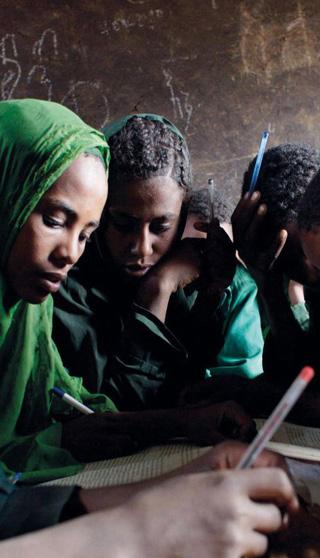



For nearly 30 years, the IYF’s top priority has been to help young people succeed by ensuring they develop the skills to earn a livelihood. Via is a partnership with the Mastercard Foundation that seeks to update and re-invent the TVET (Technical and Vocational Education and Training) systems in Tanzania and Mozambique by making their skills training more market relevant, preparing young people with the technical and life skills to be workforce ready, not just for their first job, but for a lifetime of work. Via will be driven by careful analysis of market opportunities, labour force needs and potential, and business ecosystems. It will directly benefit 30,000 economically disadvantaged youth by equipping them with the aspiration, grit and resilience to secure a decent job or the skills to start and grow enterprises.
The UK Department for International Development’s (DFID) Girls’ Education Challenge (GEC) is a reminder that job creation for girls often begins with getting them into schools. Working with NGOs and private sector partners, DFID aims to give one million of the world’s poorest girls the opportunity to improve their lives by going to school. It aims to improve literacy, numeracy and skills relevant to young women’s lives and work; to tackle harmful social and gender norms that contribute to girls being out of school; and to engage with the private sector, governments, civil society and other donors to thoroughly evaluate each intervention to understand what really works. Based on that learning, DFID plans to work with governments and NGO practitioners to shape future policies and programmes. In the first phase, the GEC programme delivered vocational training to 25,000 girls.


Career guidance is often done very badly by teachers. Often, they are not paid for it, so, for them, it is just an additional chore. Many are trying to raise standards: the International Association for Educational and Vocational Guidance (IAEVG) has a global mandate and, in the UK, Futurewise, Youth Employment UK and Adviza are doing the same nationally. In the USA, the National Career Development Association does the same, and in Australia, the World of Work Programme has inspired thousands of students.


Career network support: Bridge for Change (B4C) recognizes what has long been understood in OECD countries: that career decisions are among the hardest – and easiest to get wrong – that any child or parent faces. Given the almost total absence of career counselling in LEDCs, B4C saw the potential of peer-to-peer career counselling that would be basically free as it would be run by students themselves. Now piloted in seven schools in Dar es Salaam, it has proved extremely popular among students. It organises workshops where successful doctors, bankers, politicians, business and self-employed people explain how they managed their education to achieve what they did. Their stories are then published on the B4C website.
Cambridge Development Initiative (CDI): Because career guidance is often done poorly by teachers, CDI plans to build on B4C’s idea and create a ‘Connector Network’ of youth to connect schools with industries seeking recruits locally and encourage employers to appoint ‘connectors’ to their local schools so that each can know better what the other does.

German/Austrian/Swiss – dual system of education: Sometimes the oldest paths to youth job creation are the best, and Germany, Austria and Switzerland have some of the lowest youth unemployment rates in the world. For centuries, they have operated a dual system of education, where roughly half the country’s students are educated in college – and the half in the workplace. This means that, like the guilds of medieval times, students get hands-on training from skilled craftspeople while also being paid a small salary and learning useful workplace habits and attitudes. The UK has set up a similar programme with its studio schools, project-based learning academies where students spend more and more time in the workplace as they reach the end of their school careers.


Efforts to export the dual system to other countries have not always met with success. There is no one-size-fits-all solution to entrepreneurship education. All we know is that school is where the seeds of entrepreneurship must be sown. Review what’s worked in other countries, then create your own solution, tailored to the needs and cultures of your own community and country.


Aldridge Academies, UK: Aldridge Academies in the UK employ a novel approach to education that appears to be exportable. Each academy focuses on developing entrepreneurial attitudes, as every key stage 3 student runs a business as part of the curriculum. One of these team companies established a social enterprise which funded the building of a bakery in Uganda and the students worked virtually with local partners, exchanging ideas and shared experiences between girls in both schools. By focusing on this skills development alongside their academic qualifications Aldridge students are equipped to succeed in education, employment or self-employment.

“I can’t find a job so they tell me: Start a business, create your own job! But nothing in my 12 years of education has given me one clue how to do this.”
Rahul, Indian Delegate to PCI’s World Youth Congress, Brazil, 2012
Governments that have succeeded in changing mindsets must then create nurturing environments for all entrepreneurs be they aspirational or ‘necessity’ - forced into enterprise creation by the lack of available waged jobs. Both types must start with market research, finding gaps in the marketplace, and linking those with what they themselves want to do. This starts with ‘ideation’ and proceeds through careful research to the costing and elaboration of a viable business plan.
To become operational, most business plans require access to low-cost flexible start-up loans, supplier credits or business equipment leasing arrangements. Women, too, must have unconstrained access to such credit, and it can come in a bewildering variety of forms: angel or family investors, impact investors, venture capitalists, online crowdfunding sources (such as kiva.org and lendwithcare), peer-lending schemes, Village Savings and Loan Associations (VSLAs), and many others. Policymakers need to encourage and expand this variety. To ensure youth business startups are registered and pay taxes, governments must open up one-stop shops or online websites for easy, cheap business registration.
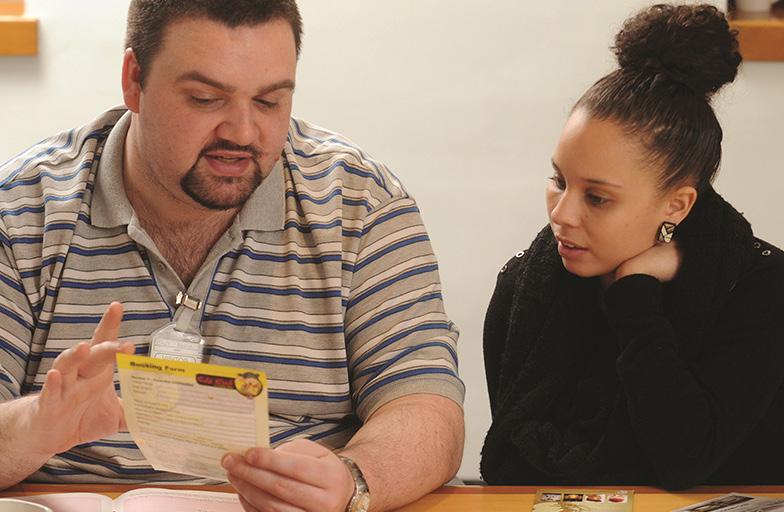
Caring mentorship is also vital: research done by Youth Business International (YBI) in several countries shows that, where there is effective mentorship, 70%-80% of youth start-ups are still in operation after three years. Where there is no mentorship, that figure falls to less than 50%. Governments must ensure that there is radical transparency about market information and their country’s own competitive advantage. Finally, governments must also lead on efforts to improve ensure wider access to hi-speed internet.
Statistics show that most jobs are created by small-to medium-sized enterprises (SMEs) and micro-SMEs. Although most governments know this, it is much easier for them – and donor agencies – to make single investments in large companies and industrial zones’ than to support a diverse range of micro-SMEs and ‘necessity entrepreneurs.’ However, with the latter creating five to 10 more livelihoods than the former, they must find ways to reach out and support those at the bottom of the pyramid. Some governments have done this:
In many LEDCs there are severe disincentives to registering your company, be they in terms of time, cost or complexity. In Rwanda, the Office of the Registrar General has set up an online business registration service to combine all registration requirements under one roof. With one application you register your business and obtain a company code that also serves as tax identification number (TIN). There is no minimum share capital required for company incorporation, and no taxes to pay.
In Namibia, the government has set up a National Youth Directorate with the goal of empowering youth through entrepreneurship training, skills development and active youth participation in responsive youth programmes. The Directorate includes the Namibian Youth Credit Scheme (NYCS), a loan guarantee programme aimed at providing loans of N$ 2 000 to N$ 20 000 to youth that do not have adequate collateral to access credit from the mainstream banking system. Operated through both individual and group lending systems, the loans are paid back with interest of no more than 20%, and beneficiaries are offered follow-up training, counselling and mentoring in business management practices. The Directorate delivers one-year training courses to out-of-school, unemployed young people who do not meet the basic entry requirements of conventional vocational training centres. A tuition fee of N$ 300 to N$ 700 is payable upon registration.
Originally designed as a way of encouraging immigration, the ‘Points-based Australia’s Skill-Matching System’ is used to match suitable skillsets to jobs available. The online assessment calculates whether each applicant has enough points to be eligible to immigrate to Australia under one of the Skilled Visa classes.


The Commonwealth Secretariat and UN Conference on Trade and Development (UNCTAD) have created a Policy Guide to Youth Entrepreneurship that explores key areas such

as access to finance, youth-friendly regulatory systems, entrepreneurship education, ICT, and the importance of supportive networks. In partnership with UNCTAD, International Labour Organization (ILO), YBI and other key youth entrepreneurship players, the Commonwealth is now using the guide to build the capacity of governments to create and strengthen national policies and strategies for youth entrepreneurship. They have worked with senior government officials from 18 countries in Africa, and are planning similar programming for the Pacific region in spring 2017.
Hand in Hand International’s systems approach to youth job creation: In 10 developing countries from Afghanistan to Zimbabwe, Hand in Hand International has helped almost 2 million people start their own small businesses, creating more than 2.8 million jobs. Although the model’s specifics vary according to local context, it always follows the same integrated steps:
1. First, Hand in Hand creates Self-Help Groups made up of 20 or so young people who support each other, save together and learn together.
2. Once a group is stable, with its savings fund firmly in place, Hand in Hand trains its members to discover and develop business plans with modules in basic bookkeeping, business development, marketing and more. Where members of the group are illiterate, Hand in Hand delivers its training in pictures, songs and parables.
3. Hand in Hand steps in to provide credit management training and access to microfinance when members need more than they can borrow from their group’s saving fund.
“… pictures, songs and parables.”

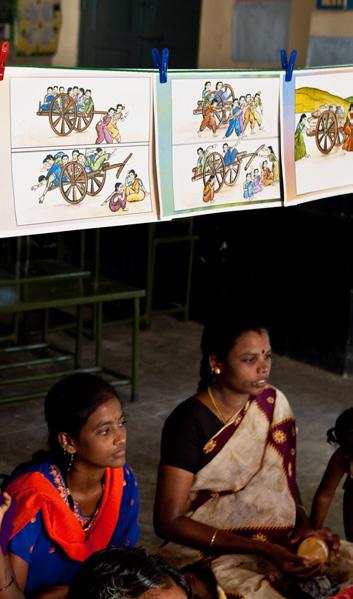
4. As a final step, Hand in Hand helps established young entrepreneurs thrive by plugging them into value chains and helping them find larger markets – connecting farmers into co-operatives, for example, then linking them to large companies such as hotel chains and Coca-Cola.
Meet Emmy Kibogong, whose Hand in Hand loan nearly doubled her income

“After being trained on how to save and start a business, I used my savings of KES 800 (US$8) to start a green grocery business selling tomatoes, onions, other vegetables and fruit,” says Emmy. “In order to keep my business growing, I applied for a loan of KES 5,000 (US$50) from Hand in Hand, which I used to add stock to my shop in order to meet the growing demand from customers. As a result, I realised a profit of KES 2,500, (US$25) which I saved in my personal account.” Emmy has since almost doubled her income, moving from KES 2,500 (US$25) to KES 4,000 (US$40) a month. But she has no plans to stop there. “I have fully settled the loan and I have recently applied for a second loan of KES 20,000 (US$200) to help me expand even further.”

Business development support targeted at the bottom of the pyramid: Peace Child International (PCI)’s Be the Change Academy (BTCA) provides free business development support to vulnerable young women in LEDCs – young women who have never been to school, who are illiterate with no obvious skills to secure employment. Currently, it is being run in different contexts across West Africa. In Guinea, it targets young women in the capital Conakry who are working as wandering sellers, often borrowing stock to sell on credit and barely turning a profit. In Sierra Leone, it works in a rural area with illiterate women from poor families who have a few assets, such as cows and land.

DFID’s KUZA project, Kenya: Kuza is a three-year youth employment programme in Mombasa County, Kenya that works with business, government and community-based organisations to identify and act on opportunities for ‘win-win’ outcomes that reduce poverty. It works at both the supply side of the labour market, helping 8,000 young people improve their employability skills, and at the demand side, supporting the creation of 5,000 employment opportunities. Kea Hamisi Athmani said: “One of the valuable lessons I learnt at Kuza is how to save. It’s how I’ve been able to finance the plastering work in my new shop. I’ve also bought a second hand computer and now give computer lessons to other young people in Mombasa.”
The BTCA programme is a step-by-step approach that aims to support young women to undertake market research, develop business ideas, choose one they are confident they can run profitably, and then develop a viable business plan. Because PCI’s target-beneficiaries are largely illiterate, the BTCAs use an integrated packet of image-based training tools and games to train and support them. At the same time, coaching aims to support them to decide for themselves what they want to do. Trainees are taught strategies to tackle the market/economic, political/legal, environmental, technological, managerial and social/cultural aspects that every business faces. The BTCAs support young people to analyse different locally available options for funding their business, be they local micro-finance institutions, local saving groups, their own savings or borrowing from family.
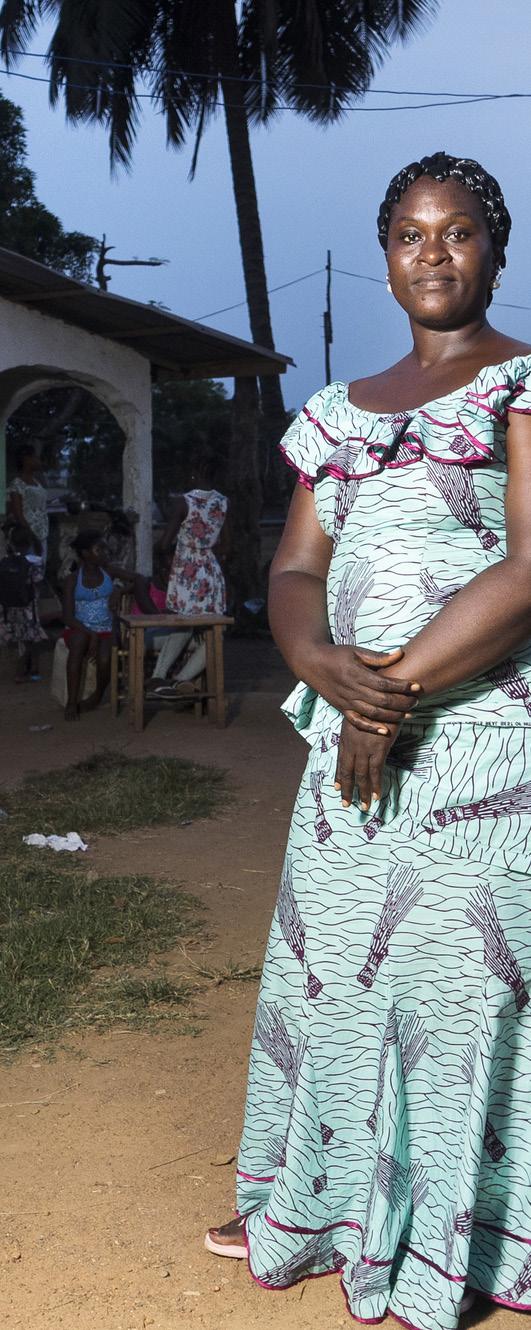

When Mangee enrolled in the BTCA, she was, like many women, running two small businesses: a catering and a bedsheet business. Both were struggling.
“I was selling bedsheets because I did not have enough money to open a restaurant. Through the support of the BTCA, the catering business could grow faster, and they could help me get contracts and grow the business. When a client wants catering, they normally choose the option that will cost them the least money. I keep my prices low - low enough that they will always consider me. Now I do not do the bedsheet business and focus solely on the catering.”
Her success is transforming her family’s quality of life. “When I took my first pay, I went into town and bought my children books, bags, uniforms and shoes. I am proud I can now give money to my children and even my husband.” She’s also pleased to be employing people. “I am changing lives and helping people. I want to open a good restaurant, and I am already in the process by securing a piece of land. After that, I would like to expand to open a chain of restaurants.”
Raleigh International offers entrepreneurship & business training as part of its delivery of DFID’s Intl. Citizen Service Entrepreneurship programme. Asha Mwapinga , a graduate of the programme in Lusitu Village, Tanzania –offers this personal assessment of the value of the training provided:
“I quickly used the skills I gained from the Raleigh training course by creating my own business plan for selling milk. I was successfully selected to receive start-up capital and I raised extra funds from my family which enabled me to buy a cow. Six weeks later, the cow gave birth and I started to earn money. The cow gives me six litres of milk per day, which I sell for TZS 1,000 per litre. I spend half of this TZS 6000 on the household and save the other half.


“The most interesting part of the training I received from Raleigh related to finance and budgeting skills. Using those skills, I set up a second business after a month to sell chips and soft drinks which earns me an additional TZS 5,000 per day. I am now conducting more market surveys and research in my village and am confident that I can expand my business in the future.”

Access to low-cost, flexible business start-up loans: In a recent PCI survey, 91% of youth mentioned the difficulty of getting a loan as the major obstacle to starting an enterprise. Though traditionally a big problem, there is now a proliferation of online, NGO, and other sources for low interest, start-up loans such as Kiva.org, Lendwithcare.org, Lending Hive, the Vision Fund, the Sparkasse Foundation etc. These + supplier credit, leasing arrangements and a myriad of other mechanisms are now sidelining the mainstream banks and MFIs where a 25% pa interest rate is considered low and rates of 60 to 100% pa are commonplace.



Youth Business International: Tusshar Munoat ‘s Indian construction company has increased its turnover 60 times in five years to US$6 million in 2016, generating thousands of jobs. “My enterprise contributes to the development of country’s rural infrastructure by building dams and laying pipelines to connect and channelize water for providing irrigation and drinking water to villages.”
Darecha: a Tanzanian micro-venture capital firm founded by Julius Shirima while he was still at school. The 2015 winner of the coveted Commonwealth Youth Award, Julius has already helped thousands of young people into business, and created tens of thousands of jobs.




Enable women to borrow for their businesses: Women are also beneficiaries of the online crowdsourced loans for start-ups, but cultural attitudes towards women’s economic empowerment means specialist programmes are often required. Goldman Sachs 10,000 women started in 2008 to provide women entrepreneurs around the world with business management education, mentoring and networking skills, and access to capital. The initiative has reached more than 10,000 women in 56 countries, resulting in immediate and sustained business growth for its graduates. Partnering with IFC, it has also raised US$600m in capital for 100,000 women around the world.
Women’s World Banking (WWB) has, over the course of more than 35 years, helped nearly 3 million women access the financial tools and resources they require to build security and prosperity. Women are typically good clients who reinvest in their families and communities, but they remain an underserved market. WWB does market research to learn what financial products lowincome women need, then develops new and practical ways for institutions to do business with women designing sustainable financial products.


Equity for Tanzania(EFTA) – Leasing equipment not lending cash EFTA enables farmers and small businesses to acquire machinery to improve productivity. As the equipment serves as the underlying collateral, entrepreneurs can obtain the equipment they need without having to risk everything as security for a bank loan. To date, EFTA has advanced $8 million creating or safeguarding over 1,000 jobs, with 20% of these going to female employees. In many companies, staff wages have doubled post investment. EFTA has also provided training and networking events to over 1,400 small businesses.
• James Rikoyan, 27, runs a brickmaking business in Tanzania. EFTA leased him highquality vibrating block machines, cement mixers and molds to improve brick quality and expand his business. He said: “EFTA empowered me to reach my goals and to become my own boss.”


• Anna Martin Mengor’iki, 29 , wanted to start a business providing private medical care to Arusha’s growing population. EFTA leased her modern laboratory equipment to support her business plan and catalyse her business’ growth.
“Loans and returnable capital have to be the finest and fairest form of development Aid because, unlike grant aid which casts the recipient in the role of a mendicant, a loan is a contract between equals. Loans empower. Grants dis-empower.”David Woollcombe, Chair of Trustees, Peace Child International (Mission: ‘Empowering Young People’)
Franchising opportunities: Franchises attract inward investment at low risk and measurably improve the management skills of a country’s young entrepreneurs with free, experiential training. This could be a promising area of growth in LEDC economies and organisations such as the International Franchising Association seek to promote such opportunities worldwide, adopting the slogan, “Owning a franchise allows you to go into business for yourself, but not by yourself.”
Paying for it – some policy ideas: Enabling successful youth business startups is not a one-off project: to succeed, it has to be available to every child everywhere. Governments – local, national and international – can do this in several ways: they can require banks to invest a percentage of their profits in their future clients (youth) or invest in arms-length instruments like Start-up Loan companies, VSLAs or MFIs for youth such as YouthBank International or those started by Julius Shirima in Tanzania, or Alpha Bacar Barry in Guinea. Online crowdsourced funding is a promising growth area, while youth-toyouth funding list over fifty funding sources for youth start-ups.




Sudokkho is a five-year DFID-funded skills training and employment programme in Bangladesh that aims to ensure the employment of 100,000 poor people, including women and young people, in the ready-made garments sector. It also aims to employ women in the male-dominated construction sector doing jobs such as house-wiring. The initiative involves the private sector to ensure skills training is relevant and of high quality, thus increasing post-training job opportunities.


Cleaning up the informal sector: The ILO’s Syndicoop programme has changed approaches to informal work in East Africa by encouraging informal traders into co-operatives. For example, the Assetamorwa motor-cycle co-operative in Rwanda obtains better deals for its members by training riders, negotiating with city authorities and traffic police etc. A similar cooperative helps traders in the Gikombo market in Nairobi. Given that the ‘informal’ will remain normal for millions of workers for many years, interventions aimed at improving informal working conditions –rather than attempting to formalize their work – need to be encouraged.



Expand mentorship opportunities: Mentorship is central to successful start-ups. It is different from consultant support because mentors provide the pastoral and personal support essential for young entrepreneurs. The Prince’s Trust (PT) pioneered the concept of mentorship which, in 35 years, has helped almost 400,000, mostly disadvantaged, young people start successful businesses. The great majority of them have grown to provide significant tax revenue to government and reduce their benefit bills. Youth Business International has franchised the model to 50 countries with similar success, convincing many policy-makers to see the wisdom of investing in mentored start-ups.
PT and YBI recruit and train effective volunteer mentors. Rockstar Mentors, by contrast, believes that paid mentors result in a more serious commitment from both mentor and young manager.
Jonathan Pfahl, Founder and CEO of Rockstar Mentors, arrived from Australia in 2005 determined to continue his career in finance. New to London and to his job at Goldman Sachs, he paid a senior staff member to show him the ropes. That initiative was the key to his success, so when he chose to move into the booming London property business, again, he spent £3,000 on a three-month mentoring programme with a multimillionaire investor. This helped him buy six houses. He became a true believer in the idea that “the fastest way to be successful in business is to go out and find someone who has already done what you want to do and to get them to show you how to do it, one-on-one.” So, in 2007, Jonathan recruited a group of highly successful entrepreneurs, each of whom had created and sold a company for more than £5 million, and created Rockstar Mentors, a one-stop shop where a young entrepreneur could choose the mentor with the achievements she or he most wanted to emulate.
Rockstar’s mentors have since supported 8,500 businesses – 70% of which have survived and are prospering. It now has an online mentoring app (http://rockstarbusinessworld.com/) that young business owners can use to search by industry, as well as by the area of that industry they need help with. On the app, Rockstar mentors give users free advice on how to succeed in that field. Then, if they want one-on-one mentorship, users can hire them for a face-to-face meeting or Skype call.
In their systematic review of youth employment programmes, World Bank, ILO and RWI and researchers conclude that “programmes solely implemented / managed by the private sector lead to moderately higher gains”. Because the private sector is where most jobs will be created – and because it is taxes paid by a flourishing private sector that will pay for any public sector jobs created – it is vital to place the private sector at the heart of all job creation policymaking.
Skills-matching is the low-hanging fruit of youth job creation. It is a no-brainer for policymakers to ensure the youth whom their massive investments in schools, TVET and universities are learning the skills that employers need – and that future growth and competitive advantage requires. It is less than promising when the CEO of one of India’s largest employers, Infosys, tells his government that, “Sadly, only about 13% of graduates from this country’s universities are qualified to be employed by my company…” It is likewise unwise for British universities to graduate 5,000-plus architects every year for less than 1,000 vacancies in the profession. Government-led skills-matching can iron out these expensive mismatches.
entra21 provides disadvantaged youth aged 16 to 29 in 22 countries in Latin America and the Caribbean with job training and placement services. The programme emphasises alliancebuilding among schools, governments, the private sector and youth themselves.
Designed to be evaluated and refined with a view to being scaled up through government partnerships, the initiative includes comprehensive training in technical and life skills based on demonstrated labour market and employer needs. From 2001 to 2011, more than 135,000 young people benefitted from participation in entra21, and employers were highly satisfied with graduates as interns and employees. entra21 has become a model for all IYF’s employability initiatives. By using advanced monitoring and evaluation tools, the initiative produced a series of studies that expanded IYF’s understanding of how to achieve scale, reach hard-to-hire youth and use technology effectively.


The oldest and still one of the most effective ways to prepare young people for the world of work, is to get them working alongside a master craftsman or woman to learn their skills and achieve professional competence. From medieval stone masons, cobblers and carpenters to modern-day bricklayers and web designers, apprenticeships ensure that young people acquire the skills and attitudes to hold down a decent job. Because workplace skills are changing fast, new kinds of apprenticeships are needed to train young people to be lifelong learners –teaching themselves the skills they need to get new jobs in fast-changing labour markets.
AIESEC is one of the world’s largest youth-run organisations, with 2,400 campus groups in 126 countries, organising tens of thousands of internships and volunteer experiences for youth leaders every year. Its target is to provide life-changing leadership experiences to 1 million young people in the next three years. AIESEC counts a Nobel Peace Prize laureate and many world, business and NGO leaders among its one million-strong alumni community. AIESEC members can experience paid internships in companies, NGOs and development organisations that see the internship as a way of recruiting and shaping top youth talent. “AISEC is a strategic talent provider –that’s how we want to grow with AISEC.” Laurence Dumont, Global Co-ordinator
 Rajeeb Dey, Founder, Enternships
Rajeeb Dey, Founder, Enternships
Enternships’ mission is to help recent graduates find the best opportunities to kickstart their careers, mostly in tech companies. Since 2009, the organisation has helped thousands of graduates finds jobs and internships in more than 7,000 companies including Telefónica’s Wayra, Propercorn, Havas, eHarmony and Santander – all with a focus on enterprise. Their blog lists some astonishing stories and ideas for how to find or create jobs.
As the World Bank noted, private sector initiatives for creating jobs are often the most successful as they are more likely to have built-in incentives to respond to the needs of employers and job seekers. Here are some well-known private sector-led initiatives:

Accenture’s Skills to Succeed programme advances employment and entrepreneurship opportunities by using technology to drive impact at scale. To date, Accenture has donated $300m to the programme, equipping 1.2 million people with skills to succeed. The programme draws on two of Accenture’s core capabilities: developing talent and convening partnerships to achieve tangible, measurable results. It has set itself and its partners the following targets by 2020:
• Demand-led skilling to equip 3 million-plus people with the skills to get a job or build a business.
• Achieve employment and entrepreneurship outcomes and improve the sector’s collective ability to measure and report on these outcomes.
• Collaborate for systemic change to bring together organisations across sectors to create large-scale, lasting solutions aimed at closing global employment gaps.
Travel and tourism – is the world’s fastest growing job sector. It is expected to add 86 million new jobs by 2026. Chris Nassetta, president and CEO of Hilton Hotels, started his career cleaning toilets at a Holiday Inn. With six daughters of his own, he has partnered with groups such as IYF to find out more about how young people think about their career paths. A recent youth survey sponsored by Hilton found that only 17% thought hospitality was an attractive career, while 47% favoured technology. Consequently, Hilton runs an annual Youth in Hospitality celebration, along with apprenticeship programmes to expose more than 1 million youth to the hospitality industry – and tell the story of how one young man who started cleaning toilets rose to become CEO.
Banking on Change(BoC): Today, more than 2 billion people have no access to financial services. Barclays Bank joined up with CARE and Plan International UK to break the barriers to financial inclusion, especially for young people living on less than US$2 a day. From 2009 – 15, the partners enabled 758,000 people to gain access to informal financial services, with young people (under 35 yrs) starting nearly 117,000 income-generating activities between 2013 and 2015. BoC proved that no one is too poor to save and that savings groups provide ‘unbankable’ youth with their first step towards financial inclusion and asset-building. Now completed, the project created many insights and learning, including the Youth Savings Group Model, which outlines good programming principles

for youth savings groups to increase their access to financial services and deliver economic empowerment through improved entrepreneurship and business skills. It also created the Linking for Change Savings Charter, which sets out international principles for linking informal groups of savers to formal banking products.
Branson Centre of Entrepreneurship – South Africa and Jamaica: The Branson Centre of Entrepreneurship focuses on providing aspiring entrepreneurs who have started a business with the skills, opportunities and inspiration to grow their businesses. It does not provide funding but assists entrepreneurs with access to networks, knowledge, resources and markets. Once they have completed the development programme, entrepreneurs are introduced to the Circle of Excellence, which gives them access to mentoring, coaching, additional programmes, workshops and initiatives. The centre also provides Business Bootcamps, impact accelerator programmes to teach business skills quickly and effectively.
UN-Exxon Road Map: It is common knowledge that when women are economically empowered, whole communities benefit. Stats such as “women produce half the world’s food” and “women spend 90% of their income on their families where men spend markedly less” have been known for a long time. But we still don’t know the most effective interventions to advance women’s economic empowerment. This Road Map is designed to fill that knowledge gap. Updated again in 2016, it confirms that the fields of entrepreneurship, farming, waged employment and young women’s employment are where the most promising high-impact, highpotential interventions lie. Among those interventions, perhaps surprisingly, saving money emerges as a top-value intervention. Owning title to a property is another necessity, especially for women. A third area of effective intervention for women is childcare, especially in urban areas.
We have already looked at some of the ways governments can directly encourage youth job creation: simplifying the business registration process, subsidising apprenticeship schemes and more. Now let’s look at some of the Active Labour Market Policies (ALMPs) governments can pursue, along with the many opportunities they have to show job creation leadership.

Historically, the largest and arguably most successful ALMP was Roosevelt’s New Deal in the USA. Under the deal the Works Progress Administration and Civilian Conservation Corps employed millions of unemployed people, mostly in construction projects, which resulted in the government becoming the country’s largest employer, delivering new schools, bridges, parks, woodland trails and other infrastructure to thousands of communities across America. The New Deal was credited with ending the Great Depression in much the same way as the post-war Marshall Plan helped employ thousands of demobbed soldiers in the effort to rebuild Europe. The indisputable success of such schemes is why Germany is currently talking about a “Marshall Plan for Africa.”
Other large direct government intervention schemes include:
• India’s Mahatma Gandhi National Rural Employment Guarantee Scheme (MGNREGS), which has provided 12 billion workdays since 2007 mostly in rural areas by providing wage subsidies.
• South Africa’s Expanded Public Works Programme (EPWP), which is designed to ensure 6 million public employment work opportunities by 2019. The South African government is proud of the success of the scheme. “The SA Stats survey… found that by March 2015 1.24 million work opportunities had been created, against a target of 1.04 million – a 119% achievement. Also, in 2014, 70% of those who participated in the EPWP were employed – up from 56,9% in 2011. And, 4 out of every 5 of those employed had a formal sector job,” according to an EPWP report.


Finland has had a job guarantee scheme since the 1990s. The European Commission (EC) drew on its success to create its €7 billion Youth Guarantee scheme, designed to ensure that all Europeans under the age of 25 receive a goodquality offer of employment, continued education, or an apprenticeship within four months of leaving school. According to the EC, “14 million [young people] have entered the scheme since January 2014 and 9 million have found jobs.” Massive though this scheme sounds, the EU feels it is cheap at the price, because it has estimated that the cost of lost economic productivity due to youth unemployment at €153 million.

At both the local and national levels, governments have immense opportunities to attract business to their districts and countries. With a substantial German-speaking population, the leaders of Spartanburg, South Carolina, heard BMW were looking to set up a manufacturing plant in the USA. With their dying textile industries threatening to turn them into a ghost town, a team of them went to Munich and, in their excellent German, persuaded BMW consider their town. Spartanburg now has the secondbiggest BMW plant in the world, employing thousands of people. With China looking to relocate 85 million jobs in the next 15 years, this is a golden opportunity for African governments to attract inward investment to accelerate the industrialisation of their countries. Helen Hai, an industrialisation consultant, has already brokered the establishment of factories in Ethiopia and Rwanda, creating tens of thousands of jobs. Millions more are in the pipeline.
Identifying individual factors that represent a risk in the labour market and performance-related contracting, a practice known as profiling, can improve outcomes. Take, for example, this example from the World Bank in Nepal: “The Adolescent Girls Employment Initiative (AGEI) in Nepal provided technical and life skills training. Training providers were selected through a competitive bidding process and offered a bonus payment based on the number of trainees who acquired ‘gainful’ employment six months after completing the training, and a second bonus for the share of participants who met pre-specified vulnerability criteria and were successfully placed in employment.”

Ultimately, youth unemployment is a youth problem so young people should participate in creating policy solutions. Policymakers must seek to empower them to lead on the implementation of their own solutions.
There are many governments and organisations that successfully empower young people. The Commonwealth Alliance of Young Entrepreneurs (CAYE), for example, harnesses young people’s potential through the formation of alliances of youth entrepreneurs. There are five regional CAYE chapters, one each in Asia, Caribbean, East Africa, Southern Africa and West Africa. The young entrepreneurs of CAYE engage with governments, the private sector, the media and other stakeholders to champion the cause of youth entrepreneurship at the local, national, regional and international levels, driving trade and advocating for a better youth entrepreneurship ecosystem. Several other governments, NGOs and intergovernmental organisations host national entrepreneur networks and promote platforms that link young entrepreneurs within and across regions.
The G20 Young Entrepreneurs Alliance (G20 YEA) is one, while the International Youth Foundation’s YouthActionNet
focuses on the immense potential for job creation in the social enterprise field.
Over 15 years, the project has created one of the world’s largest networks of young social entrepreneurs, comprising more than 1,350 young leaders in 90 countries. Biggest of all is the Kauffman Foundation’s Global Entrepreneurship Week, the world’s largest celebration of innovators and job creators who launch start-ups that bring ideas to life, drive economic growth, and expand human welfare. For one week each November, thousands of events and competitions around the world inspire millions to engage in entrepreneurial activity while also connecting them to potential collaborators, mentors and even investors. Although it is focused on all entrepreneurs, not just youth, it is now in more than 160 countries and empowers roughly 25 million people every year through 25,000-plus activities, supported by dozens of world leaders and 10,000 partner organizations.

Alianca Brazil
Lina Maria Useche, a YouthActionNet fellow, founded this entrepreneurial alliance in 2010 to give young entrepreneurs access to information, networks and guidance. It formed partnerships with universities, governments, NGOs and private sector partners such as Coca-Cola, IYF, YBI, Danone and Natura. To date, Alianca has undertaken 96 projects, trained 69 organisations in 19 states of Brazil, and supported more than 27,000 young entrepreneurs, 85% of them women.
Cambridge Development Initiative(CDI): CDI set out in 2014 to “change the way that student volunteering is done” and “improve the lives of Tanzania’s most disadvantaged youth.” Each summer, 60-80 Cambridge University students head out to Dar es Salaam to work with an equal number of Tanzanian university students on projects in 4 areas: Water & Sanitation, Health, Education and Entrepreneurship. CDI exhibits the best youth-led development, doing development projects so good, several universities from the USA and Canada, India and Peru are now seeking to emulate their model of empowering local youth to feel ownership of
their shared projects. CDI’s efforts in secondary education and social entrepreneurship follows the youth-led development model and typifies the unique ability of students to understand and revolutionise policy approaches.
CDI’s DAREnterprisers business training: Entrepreneurs improve living standards, provide inspiration and create multitudes of new jobs. So CDI runs an 8-week training course for all students interested in entrepreneurship. First run in 2014, it has won support from local universities and corporates alike, raising US$17,000 of seed capital for a total of 7 successful enterprises in 2016 alone. It is another example of CDI’s ability to act as a connector between youth and industry.
Restless Development Tanzania: Half of the population in Mbeya are young people and, as 81% struggle to find a sustainable income, their biggest concern is unemployment. So 15 young boys and girls formed the Changamkeni group to respond to this challenge by growing onions for commercial consumption. Formed in March 2016, the group received entrepreneurship training and support from Restless Development under a new project funded by Barclays Bank. After the training, the group started an entrepreneurship venture. They raised the humble sum of 75,000/= shillings(US$35) through group membership fees to rent 2 acres of land in a nearby village using the land to start their onion farm. “InNovember 2016,weharvested100sacksofonionsandsold 95ofthemat35000/=Tshseach.Thismeantwe earnedatotalof3,325,000/=(US$1.495).With theprofit,weareplanningtoexpandourfarm.” Waida Komba, Chairperson, Changamkeni Group.


In a January 2017 study, the Business and Sustainable Development Commission told that investing US$12.3 trillion in achieving the SDGs in four areas – food and farming, cities, energy and materials and health and wellbeing – would create 380 million jobs by 2030. Globally, jobs in solar industries are growing at 6.8%pa compared to a 2%pa decline in jobs in the fossil fuel industry. Green industry now accounts for 3.8 million jobs in the USA and, in Germany, the Green Economy now employs more people than the car industry.
The ILO defines a ‘green job’ as a “decent job that contributes to preserving or restoring the environment in traditional sectors such as manufacturing and construction, and in new sectors such as renewable energy, improving energy and raw materials efficiency, limiting greenhouse gas emissions, minimizing waste and pollution and supporting adaptation to the effects of climate change.”
Given that this generation’s challenge is to transition from a brown to a green economy, governments and policymakers should focus their job creation efforts on this very promising sector. Hand in Hand already does this (see case study below.) Without any prompting, YBI and IYF find that many of the business initiatives youth bring to them fall into the green economy category.
Governments should do more to encourage this by:
1. Encouraging the inclusion of education about the green economy and the SDGs in their national education provision.
2. Supporting citizen-led green economy initiatives such as Clean Tech Open (CTO). CTO has trained more than 1,200 early-stage clean technology start-up entrepreneurs in the U.S through its annual business accelerator. 70% of CTO alumni have survived, raised $1.2 billion and created more than 3,000 clean-economy jobs. The EU’s Sustainable Energy Week and the UN’s Sustainable Energy for all by 2030 project perform some of the same functions.
3. Developing Green Investment Banks to support investments in green technology. The UK’s green investment bank, started
in 2012, has already mobilised £11 billion worth of investment in green energy and other green technology start-ups – £2.7 billion from government and £8.3 billion from private investment partners. In 2016, the government started the process of privatising it completely. It projects a 10% return on its investments, allowing it to market under the slogan ‘Green and Profitable’.
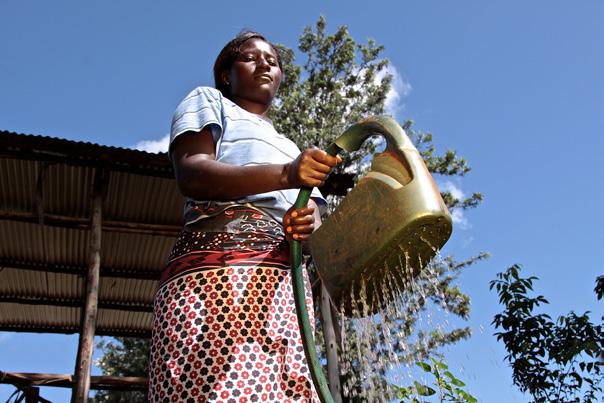
Meet Mercy Njoki, the eco-entrepreneur growing money on trees: Anyone in Mercy Njoki’s Embu, Kenya neighbourhood could spot a growing gap in the trees. But it took a special mind like Mercy’s to spot a gap in the market. “Our area
has been largely run down by businessmen who cut down trees to produce charcoal for sale,” says the mother of two. “This is because charcoal fetches a lot of money. I felt the need to restore our environment by selling tree seedlings to mitigate the effects of deforestation and promote tree planting.” In a chance conversation with a friend, Mercy learned about Hand in Hand. She signed up immediately. “I learned a lot: savings, microfinance and how to run a sustainable enterprise,” she says.
She also learnt how to spot – and grow – her market. Today, Mercy sells tree seedlings to an eco-conscious client base of learning institutions, churches and individual homeowners looking to start tree nurseries of their own. Once barely able to feed her family, her income has more than quadrupled. “I have bought a motorcycle for transporting seedlings to clients. I have a son in school and I pay for his school fees, and provide clothing and the food we eat. In five years, I can see this business filling up an entire farm. I am so happy with how I am progressing in life,” she says.
Even as IT, robotics and automation shred traditional jobs, new technologies are opening up massive opportunities for decent job and livelihood creation for youth everywhere. E-lancing, netpreneurship, mobile money and mobile apps enable tens of thousands of young people to get productive work wherever they live.

Impact Outsourcing: It is not uncommon for a small business in Chicago to get its logo designed by a young designer in the Philippines. That trend will continue and should be a target for investment. Still, many youth beg donors not to
be dazzled by flashy IT projects at the expense of mainstream, hard-slog bottom-of-the-pyramid job creation. Especially in rural areas, young people struggle to get access to enough electricity to charge their mobile phone, let alone access to a laptop. Policymakers need to make digital investments alongside investments in other fields.

The Rockefeller Foundation is pioneering innovative work in the field of “impact outsourcing” in its Digital Jobs Africa programme – a six-year, US$100 million programme to impact 1 million youth in Egypt, Ghana, Kenya, Morocco, Nigeria and South Africa. Using information technology, it seeks to inform youth about employment opportunities and deliver skills training to Africans living at considerable disadvantage to generate social and economic opportunities.
Microsoft 4Afrika: Microsoft 4Afrika focuses on three areas:
1. World-class skills: Microsoft plans to develop a self-sustaining, world-class education platform, both online and offline, to help Africans develop skills for entrepreneurship and improve their employability and competitiveness. To that end, it has established the Afrika Academy, a unique way
for students to learn and interact online with experts from across the African continent. MySkills4Afrika - bringing skilled resources from across Microsoft; Interns4AfrikaBridging the gap from learning to earning. And the AppFactory - bringing App ideas to life.
2. Access: Provide affordable access to technology, particularly cloud services and smart devices that can and will serve as a great accelerator for African competitiveness. The 4Afrika Initiative intends to help provide affordable access to smart Windows devices, including PCs, slates and phones for young Africans.
3. Innovation - Microsoft wants to help ignite African innovation for the continent and for the world. It is committed to working closely with African ISVs and developers to accelerate the development of highly relevant apps – by Africans, for Africa. It is investing in developers to enable them to get access to the technology, mentorship, connections, and go-to-market support they need to thrive.
G20 Young Entrepreneurs’ Alliance Summit, Berlin: Linking to the Hamburg G20 Leaders Summit, G20 YEA has decided to focus its 2017 summit on ‘Digital Trends for Future Business’. Five-hundred young entrepreneurs will gather for a meeting that focuses on emerging trends including the Internet of Things, Big Data, Digital Platforms, Augmented Reality and Virtual Reality. The summit shines a spotlight on the fast-moving and immensely job-rich future that lies in digital technologies.

How do you measure youth job creation? With great difficulty. Jobs come in so many different shapes and sizes, varying greatly in terms of salary, hours, permanence, formality and more. An obvious ‘end-of-pipe’ measure is cost per job created, but even that can be problematic. Our distinguished job creation partner in the Netherlands, SPARK, once had this on its homepage: “10,000 jobs created; Cost per job created: $74 to $5,868.” Which made the point. The difference between creating a job in farming and one in law or medicine is too vast to make the measure meaningful.
We must improve. The contributors to this booklet plan to work together to develop a standardised, universal measure for job creation. Such a measure must start by profiling the participants: to know the gender, educational attainment, income level, background (migrant, trafficked person, ex-child soldier, etc.), criminal history etc. of its participants. Even at the bottom of the pyramid, there is huge variety.
We also need to know how stakeholders from the first, third and government sectors are measuring their impacts. For example:
• YBI’s new Operations Management System (OMS), based on the Salesforce platform, is a cloud computing solution that allows YBI members to track their KPIs in real time.
• The European Commission’s Entrepreneurship Competence Framework tracks 15 areas of competence in three categories: ideas, resources and action.
• The Commonwealth’s Global Youth Development Index has a domain on “Employment & Opportunity” that measures: NEETs (youth Not in Employment, Education
or Training); youth unemployment (ratio of youth to adult unemployment rates); adolescent fertility rates (births per 1,000 girls age 15-19); and bank account (number of youth with accounts at formal bank)
• Plan International – Accenture’s YES!ME Monitoring and Evaluation System: This system allows Plan programme implementers and youth trainees to input and download, via mobile phone SMS, apps and the web, basic beneficiary information and data on participants’ current training and employment status. It was designed to monitor and identify next steps for Plan International youth employment programme graduates and help them secure access to decent work opportunities.
• The World Bank/IYF Practical Guide to supporting Young Entrepreneurs: Basic data gathering and qualitative analysis of Youth Job Creation information.
• CDC Group plc Job Creation Model: CDC is DFID’s private sector investment arm charged with supporting the building of business and job creation to make a lasting
difference to people’s lives in some of the world’s poorest places. It has been trialling a Job Creation Model designed to capture employment effects at different levels:
• Direct jobs: number of jobs supported and created by the investee.
• Supply chain: number of jobs and livelihoods supported and created by direct and indirect suppliers.
• Induced effects: number of jobs and livelihoods supported and created from wages spent by employees of the investee and its suppliers.
• Economy-wide employment effects from increased productivity in firms getting access to more and better finance and electricity.
According to CDC research, one job directly supported in LEDCs by an investee company is associated with an average of 7.5 additional indirect and induced jobs and livelihoods.
For the Systems Approach, we need to create national demand-side tests:
1. Quality of the regulatory environment (number of days and cost to register a business, etc.).
2. Percentage of youth with apprenticeships.
3. Success of local and national skillsmatching. How many employers are satisfied with the recruits delivered by public education systems? How many unfilled vacancies are there?
4. Percentage of young entrepreneurs who can access effective mentors.
To these some of the 33 indicators proposed by the UNCTAD/Commonwealth Policy Guide on Youth Entrepreneurship (page 84) can be added. These include supply-side indicators such as:
• Entrepreneurship education: Number of courses offered; number of start-ups/
spin-offs from secondary school and university courses; number of patents registered by young entrepreneurs, etc.
• Access to finance: Share of MFI loans received by youth under 25; existence of a youth enterprise fund, supplier credit, equipment leasing opportunities and loan guarantees; access to crowdsource / online funds, etc.
• Output Indicators: Number of youthled start-ups, their survival rate, turn-over, jobs created, etc.
International league table: As some of this data is already being collected, it would be relatively simple to create a league table of countries and donor agencies based on programme delivery. A country that offers large numbers of its young people entrepreneurship courses and access to start-up capital or equipment, mentorship, career guidance and simplified registration procedures would score high on the index. Likewise, donor agencies that invest in the field would become ‘champions of youth job creation’.
Capabilities of individual youth: Practitioners also need to monitor and evaluate the skills and capacities acquired by individual youth. If, as Kofi Annan wrote, “Youth are a nation’s most precious resource,” then metrics must be developed to measure the capabilities they acquire between the ages of 5 and 25, as well as how those capabilities expand career choices and job prospects. Amartya Sen’s Capabilities Approach is perhaps the best way of assessing this. Are societies providing youth with the choices and the skills to create a better future for themselves? Such capabilities may be seen as an individual child’s assets. As they grow through pipeline of adolescence into adulthood, they acquire skills that increase the value of their assets. These assets may be measured so that a child can achieve High Asset Value (HAV) in different areas:
• Basic skills (reading, writing and arithmetic)
• Farming or construction skills
• Management or accountancy
• Etc.
As a result of acquiring these assets, young people may acquire what the ILO calls a ‘Decent Job.’ A country with a youth population equipped with numerous HAVs is poised for economic
success in a way that a nation of numerous HAV-nots is not. An asset-based capabilities approach to positive youth development may be part of the answer to our measurement challenge as it sees youth as a precious resource, seeks to quantify the quality of that resource and gives youth a series of challenges to aspire to as they accumulate work readiness skills that they can trade in the workplace.
More work on this is needed by qualified statisticians, but with practitioners agreeing to share their data openly and transparently, it only needs one donor to step up and fund the action research required to create the evidence base for the standardised measure we all want and need.
It is our hope that you will come away from this booklet convinced of the following:
A combination, or ‘pipeline,’ of interventions is vital. It must start in early childhood and lead to a decent and fulfilling job in adulthood, be it obtained or created.
Most young people feel a lack of credit is the main obstacle to starting a successful business. Though other factors are, of course, critical, policymakers must accept this youth concern and introduce new ways of securing credit and capital for youth.
Job creation must not look to fill the vacancies of past eras but rather exploit current and future generational opportunities, aligned with the digital and engineering opportunities offered by new technologies and the green economy.
Schools and universities must connect their students with employers and the world of work. Taxes raised through commerce should be invested by governments to equip youth and students with the skills that commerce needs.
Women must be at the heart of the youth job creation system. There is still a cultural resistance to this in some societies, but the breaking of glass ceilings and the elevation of women into leadership roles is key to creating the jobs that the youth of tomorrow need.
Youth must be engaged and inspired to rise to the challenge of creating jobs from an early age, taking ownership of planning their transition from school to work and ensuring the investments made in their schooling delivers the skills and experience they need to secure – or create – a decent job.

Every reader of this booklet take that first single step towards achieving SDG 8 – full employment for every young woman and man – by taking at least one of the following Steps:
Policymakers:
Step ONE - Teach: Legislate for teachers of bottom-of-the-pyramid youth to prioritise lessons that enable their pupils to thrive in self-employment. Tailor curricula to meet the needs of all pupils, combining business skills training with literacy and numeracy lessons to ensure your country produces confident, capable young entrepreneurs.
Step TWO – Skills-match: Ensure your educational providers deliver the skills your employers – and country – need, both now and in the future. This is the lowhanging fruit of Youth Job Creation.
Step THREE – Access to capital: Support innovation in microfinance: try franchising and loan insurance; create access to Paypal, online crowdfunding etc. Make sure your regulatory systems make it dead easy for youth to access funds and start a business.
Step FOUR – Accept failure: Business failure is inevitable. Embrace it as an opportunity for learning, not an occasion to punish. Many successful entrepreneurs fail in their first attempt, learn from those failures and build success on the back of them. Legislate to make failure a beginning, not an end.
Step ONE – Learn to love entrepreneurship teaching: Career planning and the promise of profits can incentivize young people’s learning in reading, writing and maths skills. Thinking up slogans for a business idea is a great way to develop vocabulary and writing skills. Budgets and cash flows teach math. Entrepreneurs keep societies moving. Every child needs to learn how to be one.
Step TWO – Make friends with the private sector: Talk to them, welcome them into your classrooms, introduce them to your students. Make them feel that you are, in some way, working for them.
Step THREE – Prioritize career guidance: We recommend that teachers empower youth to be “connectors” here. Get youth to organize jobs fairs, career guidance seminars, work experience programmes and links with employers that expose their peers to what awaits them all in the world of work.
Let us pool our talent, our experience and our energy and put it at the service of those policymakers and donor agencies who are prepared to lead in this crucial development endeavor. And let us work with them to create the standardised measure by which we can compare the cost-effectiveness of our different interventions.
Step ONE – Take responsibility: At the end of the day, this is a youth problem. If you aspire to be a youth leader, study the issue: take a position and promote it. Discuss it with your peers.
Step TWO – Plan: Carefully plan your own career through the biggest investment that your government or parents are ever going to make in you. Add to it the work experience and private study that will help you achieve your goal.
Step THREE – Embrace peer-teaching: Statistics prove that you will learn more from teaching others than you will from reading and being taught by others.
Step FOUR – Take a stand: If you find that parents, or government, are not taking the problems you face seriously, shout about it. If you don’t, no one else will. Don’t wait for support that may never come. Take action yourself, knowing that it is better to try and fail than never to try at all.
For references and citations of facts used in this booklet, please visit the website: www.youthjobcreation.org
“Even when they’re undernourished, downtrodden and illiterate, young people have an enormous will. When they get a chance, they’re not letting it go by. They can move mountains.”
Percy Barnevik, Co-Founder, Hand in Hand International
“We need to change the psychology from ‘How do I get a Job?’ to ‘How do I create ten Jobs?’”
Dr Ngozi Okuno-Iweala, Former Minister of Finance, Nigeria“This world demands the qualities of youth: not a time of life but a state of mind, a quality of imagination, a predominance of courage over timidity, of appetite for adventure over love of ease.”
Robert Kennedy
“I believe that the world owes no man a living but that it owes every man an opportunity to make a living.”
John D. Rockefeller
“Low-income countries face obstacles including the risk of
failing to integrate a growing labour force. By 2035, the number of people reaching working age in sub-Saharan Africa will exceed that of the rest of the world combined. If we are not able to provide this coming generation with a livelihood and a chance to share in global welfare, we should be prepared for migration and political strife at an unprecedented level,”
Christine Lagarde, Director, International Monetary Fund“While there is no magic wand that will solve the problem of youth unemployment globally, there is a great deal that governments, workers and employers can do to make a difference. In the interests of inclusive economic growth and an equitable transition to a more sustainable world, a sharper international focus on the issue of youth unemployment must be adopted.
Guy Ryder, Director, International Labour Organisationwww.youthjobcreation.org
